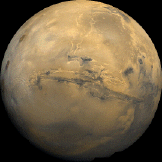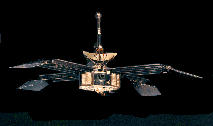 The History of Mars Exploration
The History of Mars Exploration The History of Mars Exploration
The History of Mars Exploration
 For
hundreds of years our observations of Mars were restricted by the vast
distance separating Earth from the red planet. About once every two years,
at its closest approach (called opposition), Mars passes within about 55
million km of Earth and it is then that we are able to capture pictures
of maximum resolution with earth-based telescopes. The Hubble Space Telescope
now provides us with excellent views from earth-orbit, but until the launching
of probes to Mars to collect and relay data back to Earth, much of what
was "known" about Mars was based on fuzzy pictures which showed
only large scale planetary features and events. Some of the earth-based
observations were: orbital and rotational dynamics, atmospheric phenomena,
seasonal variations in the polar caps, variations in surface color (which
were explained by theories ranging from the presence of vegetation, to
water bodies linked by martian-made canals, to variations in surface composition);
all of which resulted in a variety of interpretations. Atmospheric pressure
and composition, as well as surface temperature, was studied using spectroscopy,
but there was much debate about the varied results obtained by different
studies.
For
hundreds of years our observations of Mars were restricted by the vast
distance separating Earth from the red planet. About once every two years,
at its closest approach (called opposition), Mars passes within about 55
million km of Earth and it is then that we are able to capture pictures
of maximum resolution with earth-based telescopes. The Hubble Space Telescope
now provides us with excellent views from earth-orbit, but until the launching
of probes to Mars to collect and relay data back to Earth, much of what
was "known" about Mars was based on fuzzy pictures which showed
only large scale planetary features and events. Some of the earth-based
observations were: orbital and rotational dynamics, atmospheric phenomena,
seasonal variations in the polar caps, variations in surface color (which
were explained by theories ranging from the presence of vegetation, to
water bodies linked by martian-made canals, to variations in surface composition);
all of which resulted in a variety of interpretations. Atmospheric pressure
and composition, as well as surface temperature, was studied using spectroscopy,
but there was much debate about the varied results obtained by different
studies.
The earth-based observations of Mars paved the way for spacecraft exploration of the planet. So many questions had been raised about Mars and there were so few answers. Did life exist on Mars in the past or present? Was water present on the planet? If so, what form was it in? What was the atmosphere composed of and what were its dynamics? Could Mars be used to tell us more about the evolution of both Earth and our solar system? These were some of the questions which captured the imaginations of scientists from many disciplines, and the answers could only be found by direct observation. Judging by the reaction to the H.G. Wells "War of the Worlds" radio broadcast, the public was not immune to the mysteries of Mars either. Fueled by the curiosities of both the scientific community and the public, on November 28, 1964 at 9:22 EST Mariner 4 was launched and 228 days later it would become the first spacecraft ever to visit the red planet.
SUCCESSFUL NASA MARS MISSIONS TO DATE

|

|

|

|
![]() Chronology of Mars Exploration
Chronology of Mars Exploration
![]() Back to Mars Exploration Homepage
Back to Mars Exploration Homepage
![]() NSSDCA Planetary Science Homepage
NSSDCA Planetary Science Homepage
 Author/Curator:
Author/Curator: